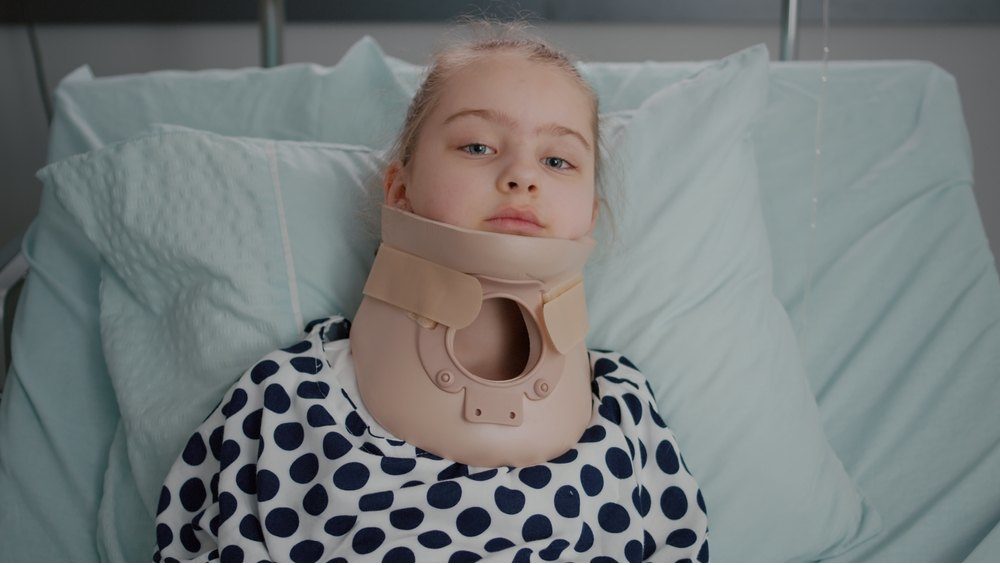 No matter the location, a fracture is painful and disruptive to your everyday life. Fractures in children can be especially hard to manage because young children may not understand why they are in pain or what has happened. Fractures are a common car accident injury as extreme force is easily exerted on a body due to the high speed at which vehicles can travel.
No matter the location, a fracture is painful and disruptive to your everyday life. Fractures in children can be especially hard to manage because young children may not understand why they are in pain or what has happened. Fractures are a common car accident injury as extreme force is easily exerted on a body due to the high speed at which vehicles can travel.
Fractures require rest and often long activity restrictions which can be difficult to impose on a child. The good news for children and parents is that broken bones heal relatively fast, more so in children than in adults. The average healing time is 6-8 weeks, depending on the severity of the fracture. Your orthopedic specialists at AICA Orthopedics Marietta can give you an idea of what to expect from the healing process of your broken bone.
Causes of Pediatric Fractures
A fracture happens when excessive force is placed on a bone, causing it to fracture or break. Fractures can be the result of car accidents, sports injuries, and slips and falls. If you suspect a fracture, it is important to seek prompt medical treatment. AICA Orthopedics Marietta offers diagnostics and treatment for comprehensive treatment of fractures.
Some common causes of pediatric fractures include:
- Playing on a playground
- Trampolines
- Sports, especially high-contact sports like soccer, football, and basketball
- Bicycling
- Skateboarding and rollerblading
- Falls
Signs and Symptoms of a Fracture
Children’s bones are still growing, so the fractures they suffer can be less severe than in adults. One in three healthy children will break a bone at some point in their childhood, so it isn’t an uncommon injury at all. Pediatric bones are a little more flexible, allowing them to withstand higher amounts of force without fracturing. This does not mean that your children will not be experiencing pain when injured.
Symptoms of a fracture can include:
- Pain, sharp and throbbing
- Swelling in the surrounding area
- Bruising
- Visible deformity of the area
- Trouble moving the affected limb or joint
- Unable to hold any weight
- Painful to the touch
- Visible bone protruding from the skin
If your child is experiencing any of these symptoms, it is important to seek medical treatment. Severe symptoms require emergency treatment. Bleeding, exposed muscle or bone, and unconsciousness are all symptoms that require a trip to the emergency room for the fastest treatment of broken bones. If your child has suffered an injury, but you aren’t sure if a fracture has occurred, you can call AICA Orthopedics in Marietta to be evaluated for a fracture by the area’s top orthopedists.
Types of Pediatric Fractures
Growth Plate Fractures
The growth plate is located at the end of the bone and is soft cartilage until it fully hardens as you finish growing. Because they are soft, growth plates are at a higher risk for injury. Growth plate fractures should be treated promptly, as the damage they sustain can affect the future growth of your child’s bones, potentially causing lifelong issues.
The most common growth plate fractures happen to the fingers, followed by the radial growth plate and the growth plates of the lower leg. Growth plate fractures are classified by the Salter-Harris classification system to help establish the type of fracture and the best way to treat it.
Greenstick Fractures
Named for the similarity in appearance to trying to break a young tree branch, a greenstick fracture is when one side of the bone is broken, causing the other side to bend. These are most common in pediatric patients due to the flexibility of their bones. These are usually put in a cast to immobilize the break while it heals. Occasionally surgery is needed to reduce the fracture before being immobilized.
Buckle Fractures
Also called a torus fracture, a buckle fracture is the most common pediatric fracture. They usually happen around the wrist after a fall. It is similar to a greenstick fracture, as the bone doesn’t break all the way through; rather, it bends. In the case of buckle fractures, the bone cracks and bends outward or dents.
Stress Fractures
Sometimes a stress fracture is called a hairline fracture. These fractures are tiny cracks in the bone and are one of the most common sports injuries. Stress fractures are a type of overuse or repetitive motion injury. They are the result of muscles being unable to absorb shock due to fatigue.
Stress fractures typically occur in weight-bearing bones like the lower leg or feet. Stress fractures are harder to treat, mostly due to non-compliance. They are painful, but often not as painful as other fractures, so people will not rest as much as they should, and re-injury is common.
Spiral Fractures
Spiral fractures can be severe and hard to heal due to the complexity of the fracture. These broken bones occur when a twisting motion is applied to the bone, causing a break or fracture to form in a spiral pattern. This causes the pieces of the bone to have uneven break surfaces and usually do not align well, bringing about complications in the healing process.
Spiral fractures almost always require surgery followed by immobilization with a cast. They are most often found on longer bones such as the femur, humerus, tibia, etc. Spiral fractures are often associated with abuse cases due to the amount and type of force required for them to occur.
Metaphyseal Fractures
This fracture is found on the long bones of the body. It is a fracture across the upper or lower shaft of the bone without affecting the growth plate.
Nondisplaced Fractures
This type of fracture is not a fracture that goes through the bone completely. The bone will stay aligned and usually stays in the best position for healing. These fractures tend to heal quickly and may only require a splint or brace to help promote healing.
Most Common Bones to Fracture in Pediatric Patients
Wrist
Children suffer wrist fractures often as a result of falls. Children are busy people and are often running around or climbing on playgrounds or things too high from the ground. The instinct when falling is to put your hands out to catch yourself, often resulting in a wrist fracture.
A wrist fracture is more commonly a fracture of the distal part of the forearm. The distal radius is a weak bone when compared to other parts of the forearms and wrist, putting it at a higher risk of injury.
Collarbone
Probably the most common pediatric fracture, collarbones are very vulnerable to impact. They are common breaks in active children, especially ones who play contact sports or are prone to falls. These are treated with immobilization using a sling or brace.
Elbow
A frequent fracture suffered in falls, the elbow is a tricky fracture and can easily be prevented by wearing elbow pads during activities with a high occurrence of falls, such as skateboarding.
Leg
Similarly to collarbone fractures, pediatric leg fractures are very common in children who participate in sports. Children are more likely to break the bones of the lower leg, the tibia and the fibula, instead of the femur.
How do broken bones heal?
 The healing of a broken bone is a multi-step process. This process has three distinct phases during which the body protects, repairs, and strengthens the bone after trauma. A child’s bones have a thick layer of connective tissue known as periosteum surrounding them. This surrounding tissue helps to prevent injury and fracture but thins as you grow, so it provides less protection for adults.
The healing of a broken bone is a multi-step process. This process has three distinct phases during which the body protects, repairs, and strengthens the bone after trauma. A child’s bones have a thick layer of connective tissue known as periosteum surrounding them. This surrounding tissue helps to prevent injury and fracture but thins as you grow, so it provides less protection for adults.
Inflammatory Phase
This phase is the first phase to occur after a fracture. Your body reacts to the trauma by sending blood to the area. This blood will form a protective clot around the break, helping to stabilize it.
Repair Phase
The second phase of your bone healing is the repair phase. During this phase, the first week sees a protective callus form around the break. The callus is a ‘sleeve’ of spongy collagen, cartilaginous material, and osteoblasts that protect and continue to stabilize the fracture. During the second part of this phase, the callus will continue to harden into a bony callus, increasing stability and promoting healing.
Remodeling Phase
The bony callus surrounding the fracture is the foundation of the new bone. New blood vessels anchor themselves to the callus, and osteoblasts begin building stronger mature bones. The osteoblasts create a bridge across the break, forming a new bone. New bone will have completely repaired the fracture within a couple of months. The new bone is stronger and thicker than the previously existing bone. The new bone is strong enough that a new fracture will never occur in the same spot again.
Diagnosing a Pediatric Fracture
If you suspect a fracture, seeking treatment promptly will help you have the best outcome in your healing journey. Once you arrive at AICA Orthopedics our doctors will use state-of-the-art imaging equipment to assess your injuries and get the best visuals possible to assist in developing your treatment plan.
X-ray: This form of medical imaging is used to see the skeletal aspects of a patient’s body. X-rays will show fractures and dislocations. Some hairline fractures are hard to identify on an x-ray.
CT: A more detailed scan than an x-ray, but it is very similar. A CT, or computed tomography, is used to obtain highly detailed images of fractures or complex injuries that may include fractures.
MRI: Some fractures can be detected on an MRI, or magnetic resonance imaging, due to the detail in the scans.
Treatment of Pediatric Fractures
 Bone fractures are best treated by an orthopedist like AICA Orthopedics Marietta. Our specialty is orthopedic injuries, including fractures. We have specialists in both sports and car accident-related injuries, so your child will be in experienced hands.
Bone fractures are best treated by an orthopedist like AICA Orthopedics Marietta. Our specialty is orthopedic injuries, including fractures. We have specialists in both sports and car accident-related injuries, so your child will be in experienced hands.
Fractures are treated based on severity and location. There are both surgical and nonsurgical methods dependent on several factors.
Open fractures are classified as such when the broken bone pierces the skin and protrudes into the open. A closed fracture is just the opposite, a fracture that stays below the skin.
Open fractures will always require some surgical intervention. These fractures are complicated and often have associated debris in the wound. The surgeon will reduce the fracture and stabilize it with pins, screws, or plates. Then any repairs to the surrounding tissue will be made. Once this has been completed, the fracture will typically be immobilized with the use of a cast or brace.
Closed fractures may need surgery but can often be immobilized with a cast, splint, or brace. Depending on the type of fracture, it may still need to be reduced, or realigned, prior to applying any kind of support or immobilization material.
Splints are used primarily on freshly broken bones that are at risk for extreme swelling. A splint will stabilize the break until the swelling reduces, and a plaster cast can be applied. A splint can also be used on minor fractures that do not require a full cast.
For fractures that need total immobilization and protection, a plaster cast will be applied. Made of two layers, a soft cushion inside, and wrapped in plaster, these casts are the most durable. However, they can’t get wet and can cause irritation of the skin if not cared for properly.
Occasionally a boot, or air cast, can be used during the healing process for a fracture. A boot immobilized the foot and ankle allowing them to heal but can be removed for bathing and treatments like icing the injured area. Boots are commonly used when swelling is going to be a known issue during the healing process.
Contact AICA
Treating broken bones and managing all your follow-up care through the recovery process is our specialty at AICA Orthopedics Marietta. Our office is staffed 24/7 and offers same-day appointments to take care of any suspected fractures with prompt and expert care. We take a comprehensive approach to treatment, so from the moment you come in we will be working with our orthopedic doctors, physical therapists, and chiropractors to develop the best treatment plan for you and your child. Pediatric injuries can be stressful due to their young age, but our team is ready to help you with any questions you may have.